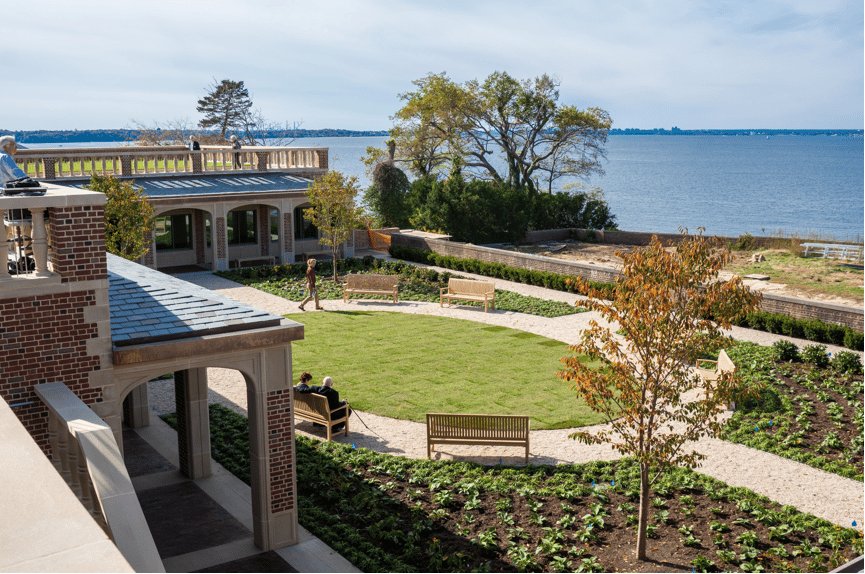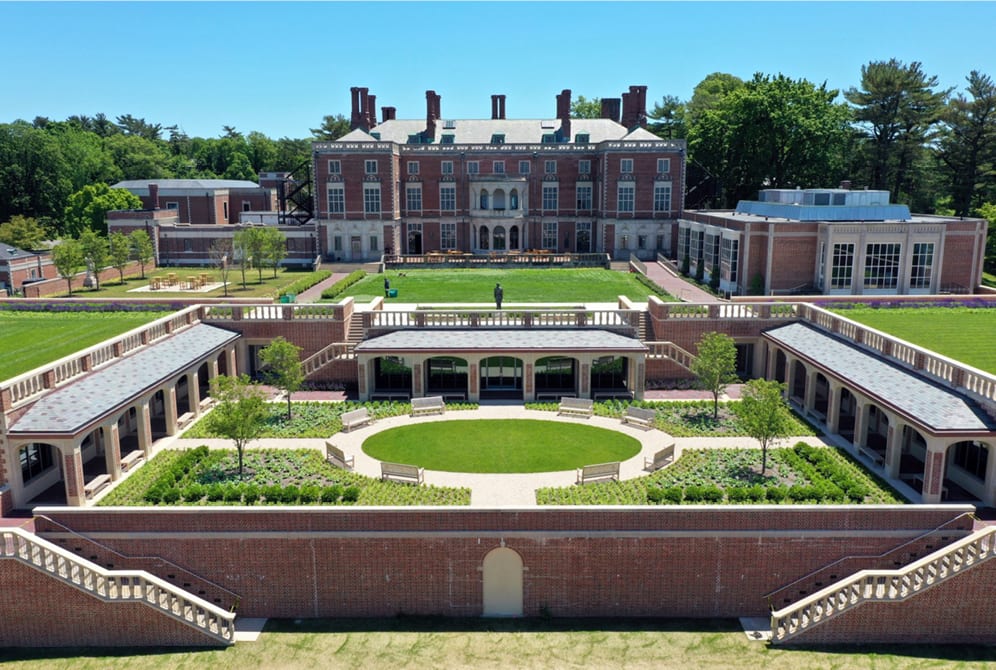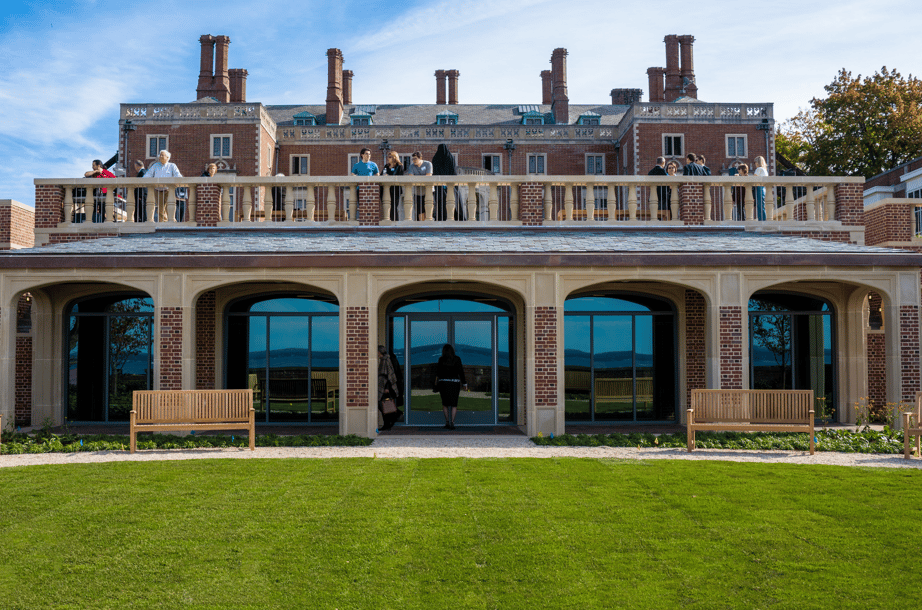Webb Institute
A marine engineering college embraces collaborative learning with a new addition to its historic campus.
STreet level
By Sneha Mehta
Bentel & Bentel received a 2022 Preservation Long Island Excellence Award for Webb Institute’s Couch Academic Center. Photo credit: Courtesy of Bentel & Bentel, Architects/Planners AIA
Perched on the edge of the Long Island Sound, with exceptional access to the ocean, the Webb Institute of Marine Engineering and Naval Architecture is an exemplar of immersive education. It is the only institute in the United States offering this dual degree, with a small, passionate group of students who live and work out of the institute’s campus: the sprawling, 26-acre former waterfront home of industrialist Herbert L. Pratt in Glen Cove, New York. Since its founding in 1889, the institute has been training its students in the most vital elements of successful seamanship: physics, ethics, and teamwork.
Prior to its move to Glen Cove in 1947, the Webb Institute was based in Fordham Heights in the Bronx. When it relocated out of the city to the historic estate—formerly known as The Braes and designed by James Brite in 1912—the institute developed a community-oriented culture by housing student accommodation, classrooms, dining facilities, and faculty offices all within the mansion. But it included only men’s dorms, not women’s. In 2016, the institute and the architecture firm Bentel & Bentel undertook the addition of a new academic building to the estate so all dorm rooms could be moved into the main building—enhancing the communal experience and designing new classrooms as modern and collaborative learning spaces.
“Adding to the 1912 mansion was complicated. What new structure could rest comfortably next to it?” said Dr. Carol Bentel, FAIA, ASID, FIIDA, partner at Bentel & Bentel. “We decided the addition should support the majestic building, not compete with it, or touch it. We also felt the history of the site was as important as the building.”
The new 30,000-square-foot addition—which Bentel refers to as a “non-building”—was built under the sloping terraces leading from the mansion toward the Long Island Sound. Hidden from sight under the handsomely landscaped roof, the addition does not interrupt the mansion’s views of the sound and its many passing vessels. Bentel & Bentel also incorporated the four ornamental niches that were part of the mansion's original garden terrace and the collegiate arches from the Gothic manor—which was used as the set for Wayne Manor in several Batman movies—into the design of its academic center. “We believe that when it comes to additions to historic buildings, the two parts—old and new—should speak to one another,” added Bentel.
The old classrooms allowed for traditional instruction: a teacher lecturing students from the front of the room. But the new classrooms feature mobile technical equipment in the lecture halls and studios, so there’s no fixed orientation. Instead, students and faculty can circulate and work in groups as they wish, infusing fresh energy into their study of the art and science of designing ships. Le Corbusier, who believed that ocean liners were “a liberation from the cursed enslavement of the past,” wrote in Towards a New Architecture that they represented a “great epoch” and “a new spirit.” Students at the Webb Institute now race toward the next great era of marine engineering in their state-of-the-art academic center and historic dorms—all with an uninterrupted view of the ocean lapping at their door.



Perched on the edge of the Long Island Sound, with exceptional access to the ocean, the Webb Institute of Marine Engineering and Naval Architecture is an exemplar of immersive education. It is the only institute in the United States offering this dual degree, with a small, passionate group of students who live and work out of the institute’s campus: the sprawling, 26-acre former waterfront home of industrialist Herbert L. Pratt in Glen Cove, New York. Since its founding in 1889, the institute has been training its students in the most vital elements of successful seamanship: physics, ethics, and teamwork.
Prior to its move to Glen Cove in 1947, the Webb Institute was based in Fordham Heights in the Bronx. When it relocated out of the city to the historic estate—formerly known as The Braes and designed by James Brite in 1912—the institute developed a community-oriented culture by housing student accommodation, classrooms, dining facilities, and faculty offices all within the mansion. But it included only men’s dorms, not women’s. In 2016, the institute and the architecture firm Bentel & Bentel undertook the addition of a new academic building to the estate so all dorm rooms could be moved into the main building—enhancing the communal experience and designing new classrooms as modern and collaborative learning spaces.
“Adding to the 1912 mansion was complicated. What new structure could rest comfortably next to it?” said Dr. Carol Bentel, partner at Bentel & Bentel. “We decided the addition should support the majestic building, not compete with it, or touch it. We also felt the history of the site was as important as the building.”
The new 30,000-square-foot addition—which Bentel refers to as a “non-building”—was built under the sloping terraces leading from the mansion toward the Long Island Sound. Hidden from sight under the handsomely landscaped roof, the addition does not interrupt the mansion’s views of the sound and its many passing vessels. Bentel & Bentel also incorporated the four ornamental niches that were part of the mansion's original garden terrace and the collegiate arches from the Gothic manor—which was used as the set for Wayne Manor in several Batman movies—into the design of its academic center. “We believe that when it comes to additions to historic buildings, the two parts—old and new—should speak to one another,” added Bentel.
The old classrooms allowed for traditional instruction: a teacher lecturing students from the front of the room. But the new classrooms feature mobile technical equipment in the lecture halls and studios, so there’s no fixed orientation. Instead, students and faculty can circulate and work in groups as they wish, infusing fresh energy into their study of the art and science of designing ships. Le Corbusier, who believed that ocean liners were “a liberation from the cursed enslavement of the past,” wrote In Toward a New Architecture that they represented a “great epoch” and “a new spirit.” Students at the Webb Institute now race toward the next great era of marine engineering in their state-of-the-art academic center and historic dorms—all with an uninterrupted view of the ocean lapping at their door.
